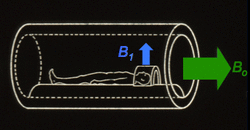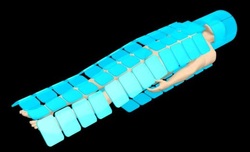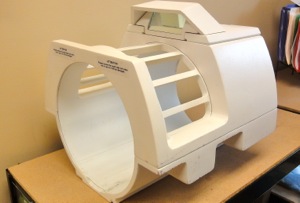
The B1 RF-field is perpendicular to Bo
RF-coils may serve as transmitters, receivers, or both.
When used as transmitters, RF-coils generate an oscillating/rotating magnetic field (denoted B1) that is perpendicular to the static main magnetic field (Bo). If the oscillation of B1 closely matches the natural precession of nuclear spins near the Larmor frequency, energy is deposited into the spin system causing a change in its net alignment. The B1 field is generated by the transmit RF-coil in response to a powerful current generated by the scanner's transmit circuitry. B1 is typically turned on for only brief periods of time (a few msec), called “RF-pulses.” By adjusting the magnitude or duration of these B1 pulses, the nuclear spin system can be rotated by variable flip angles, such as 90º or 180º.
When used as transmitters, RF-coils generate an oscillating/rotating magnetic field (denoted B1) that is perpendicular to the static main magnetic field (Bo). If the oscillation of B1 closely matches the natural precession of nuclear spins near the Larmor frequency, energy is deposited into the spin system causing a change in its net alignment. The B1 field is generated by the transmit RF-coil in response to a powerful current generated by the scanner's transmit circuitry. B1 is typically turned on for only brief periods of time (a few msec), called “RF-pulses.” By adjusting the magnitude or duration of these B1 pulses, the nuclear spin system can be rotated by variable flip angles, such as 90º or 180º.
|
When used as receivers, RF-coils are responsible for detecting the MR signal. The oscillating net magnetic flux from the excited spin system can be captured by the coil in which an induced electric current is generated. This current is then amplified, digitized, and filtered to extract frequency and phase information. Today RF receive-only coils are often collected into large arrays for use in parallel imaging applications.
Although RF-coils serving both transmit and receive functions were once the norm, today’s modern scanners mostly utilize separate transmit and receive systems. However, some special parts transmit-receive RF-coils are still in common use, especially those used for head and knee imaging. The physics and design of each of these coil types is different and will be flushed out in more detail in subsequent Q&A’s. |
Advanced Discussion (show/hide)»
No supplementary material yet. Check back soon!
References
Klomp D, Konig W, Hoogduin H et al. Practical design of RF transmit and receive arrays. Proceedings of European Society of Magnetic Resonance in Medicine and Biology (ESMRMB) Congress, Leipzig, 2011.
GE Healthcare. MR Field Notes: RF Coils...They've come a long, long way. 2005.
Klomp D, Konig W, Hoogduin H et al. Practical design of RF transmit and receive arrays. Proceedings of European Society of Magnetic Resonance in Medicine and Biology (ESMRMB) Congress, Leipzig, 2011.
GE Healthcare. MR Field Notes: RF Coils...They've come a long, long way. 2005.
Related Questions
I don't understand all the different types of coils in MR. Can you make sense of these?
How do RF-transmit coils work?
I don't understand all the different types of coils in MR. Can you make sense of these?
How do RF-transmit coils work?


